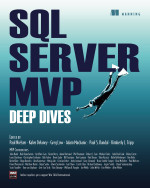
"I want to know where my data is,
physically!" This was the repeated demand of the gentleman sitting next to me at last night's SQL SIG talk on
SQL Azure-- Microsoft's new cloud-based RDBMS. (Of equal concern was, once his data was inevitably lost or compromised, "Who do I sue???") The pitch was so perfect, he could have been a plant-- those of us who were skeptical about data in the cloud, having just heard our prejudice given an angry voice, were suddenly defending it.
Still, it's easy to understand his frustration. In the cloud-heavy world of NetFlix, Rhapsody, and Amazon Kindles, an increasing percent of the media and information in our private lives isn't on our bookshelves-- it's
out there somewhere. I used to buy CDs and DVDs obsessively, but now spend $9 a month to access a vastly larger collection online. Like the old chestnut about beer, you don't
buy media anymore, you
rent it.
Microsoft wants to turn your SQL Server into such a commodity, and they have a pretty good start on it. SQL Azure is part of the
Windows Azure platform, that lets you host web applications in the cloud. What's appealing is that the interfaces for both managing and programming SQL Azure are the ones you're used to: you can connect SQL Management Studio and BIDS (at least the latest versions) to your Azure server and they behave exactly the same as they would with your real SQL Server, at least in most cases. Connecting to an Azure database with ADO.NET is transparent --but for the connection string-- and you use the same Connection and Command objects.
In short, once you've set up your Azure server and database, you can almost forget that the data's in the cloud and not on your local server. Almost. Context switching ("USE Database2") and three-part naming ("select * from database2.dbo.mytable") don't work-- you have to stay in your own database. Connections have some new behaviors and errors to respond to connectivity issues and other throttles-- Azure kills transactions that run longer than 5 minutes, for example. But for smaller, non-complicated apps, it's pretty smooth.
So where
is your data, physically? When you sign up for an Azure account, you pick a geographic location (currently pretty large regions) and Microsoft holds your database on a farm of servers across multiple locations, with replication handled automatically. Essentially your server becomes a black box to you-- your traffic will be routed through load balancers to the right place, and server resources can be added instantly as activity grows and shrinks.
How about performance? Here's where your application architecture may need to change. If you have a stateless web app that's already designed to live in a web farm nicely, you're probably set-- host your web application on Windows Azure servers, and set some affinity settings to make sure your app and database servers in the cloud have good connectivity. This is called Near Computing, because your business logic is close to the database.
If you have more of a two-tier app, you'll need to adjust to the increased latency of accessing data in the cloud, and some of the new behaviors mentioned above. Depending on how chatty your app is with the database server, this isn't trivial. If you're already optimized for poor network latency (say, if your database server is across a wan from the application), it may not be that much different.
There's also some hybrid methods to sync your local SQL database with an Azure database, asynchronously, so you can migrate parts of your app to the cloud and leave others local where it makes sense. This sounds like a bit of a nightmare but might be a good choice for broad applications that might benefit from moving certain functions into the cloud.
Certainly, if your application is entirely local, connected, and speed-sensitive (say, an inventory and routing app where the users are inside the warehouse and connected directly to the data at all times), moving to the cloud might not be a fit. But for bringing small apps online quickly, and particularly when your users are already geographically scattered, it's a tempting architecture.
Licensing plans are still fairly immature, and more complicated features like service broker haven't been implemented yet, but Microsoft is pretty excited about this, and they're certainly not the only ones with their head in the Cloud.
If I were building a new app from scratch today, I'd give Azure a good solid look-- and I might also have my lawyer figure out who to sue.



